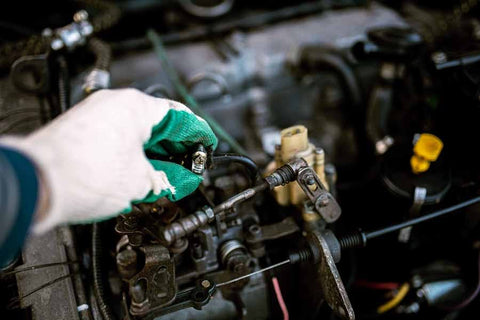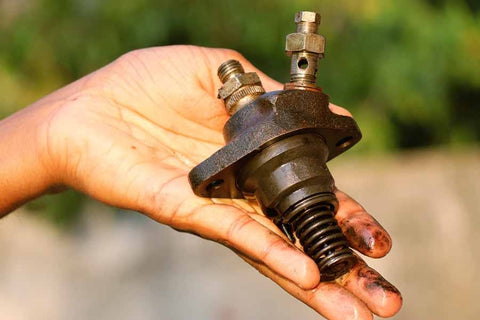Several things can cause a fuel injector pump to leak. The good news is that it is easily detectable. And if it is repairable, you can follow the steps on how to fix a leaking fuel injector pump to solve the problem.
To assist you with the repair and possibly save you hundreds of dollars, we’ve covered all the easy solutions to a leaking injector pump in one straightforward guide. Even if you don’t know anything about injector pumps and repairing diesel vehicles, we are confident you can troubleshoot and fix the problem in no time.

What Are the Symptoms of a Leaky Fuel Injector?
What steps can I take to fix a leaking fuel injector pump? If you wonder, you should start by ensuring the fuel injector pump leaks. Noticing the following signs is a good indicator that your fuel system has a leakage. It may be coming from your fuel injector pump:
- The smell of diesel inside the car
- Hard starting on a hot engine
- Poor emissions
- Fewer miles per gallon than usual
- Disrupted air/fuel ratio leading to poor engine performance
- Rough idle
- Engine misfire
In addition, a leaky fuel injector has two dangerous symptoms: oil thinning and hydro-lock. You should never ignore these signs and take immediate action for injection pump repair. If you don't, you might risk causing serious damage to your engine.
Common locations of fuel injector leakage
Before we explain how to fix a leaking diesel injector pump, it is important to understand the common locations for fuel injector leakage. The injectors generally can leak from the following places:
- The nozzle
- The O-rings
- The body
- Pintle, ball, or disc
The symptoms of a leaking fuel injector may vary according to where the leakage occurs. You may determine where the leak comes from according to the faulty codes you get when troubleshooting the vehicle.
For instance, if you get the code P0172 for a rich condition, the leakage might come from the nozzle. A rich condition means the injector pump gets more fuel and less air than normal.
On the other hand, if you get a code for lean condition, P0171, the leakage might be coming from the O-rings or the body. Lean condition is the opposite of rich condition. In such situations, there is more air and less fuel than there should be.
When Can Leaking Fuel Injectors Be Repaired?
Many factors have to be taken into consideration to determine whether an injector pump can be repaired. Well, it depends on the leakage location.
Here is a general overview of when can a fuel injector be repaired, and when it is time to replace it. This table applies to both top-feed and side-feed fuel injectors.
|
Leakage location |
Repair or replace? |
|
Top of O-ring in the fuel rail |
Repairable |
|
Fuel injector body |
Must be replaced |
|
Damaged or corroded pintle, ball, or disc seat |
Must be replaced |
|
Dirty pintle, ball or disc |
Repairable |
How to Fix a Leaking Fuel Injector Pump
The steps on how to fix a leaking fuel injector pump mainly depend on the location of the leakage. More specifically, if the fuel injector leaks from the O-ring, the problem can be fixed by replacing the O-ring. On the other hand, if the fuel injector pintle, ball, or disc is dirty, you might fix the leak with an ultrasonic fuel injector clean.
1. Depressurizing and disconnecting fuel lines
Before rolling your sleeves and following the steps for fixing your fuel injector pump, you must ensure it is depressurized. It is not as complicated as it sounds. You just need to let the engine cool down and remove the fuel cap.
Then, you must disconnect the fuel lines. To do that, you need to locate the clips on the hard lines and undo them. You should continue by disconnecting the first cylinder's injector line to gain access to the other injector lines. In removing the injection lines, you should use a wrench.
2. Removing locks and cleaning
Next, you should remove the locks on the top of the valves. Once they are removed, you should clean the area and ensure no dirt or debris around it. Avoid using water because it could enter the vehicle fuel system and cause damage.
We recommend doing that with a carb cleaner because it dries quickly. At best, you should soak the injectors in a carburetor cleaner for several hours. This way, you will be sure they are clean from the carbon deposits.
3. Replacing components and connecting lines to prevent leaks
If there is a need, you should replace the copper seats and O-rings if you determine that the leak is coming from there. If the O-rings are the problem, gently cut them off using a razor blade and place the new ones.
Lastly, you must connect all the lines in place. Ensure they are not damaged and connected to the correct spot.

How to replace a fuel injector pump
If the above-mentioned steps don’t help with your problem and you notice that the fuel pump is still leaking, it might be time to rebuild a diesel injection pump or get a new one. Here is how you can do that:
- Relieve the pressure from the fuel system by letting it cool down.
- Disconnect the electrical system and take out the fuel injection lines.
- Locate and remove the crankshaft pulley.
- Disconnect the fuel feed, return lines, and wiring assemblies.
- Find the locking screw on the fuel pump and loosen the locking screw.
- Rotate the fuel pump by using counterclockwise motions.
- Remove the nut, washer from the shaft, and set screws and brackets.
- Detach the fuel injection pump from the cylinder block.
After removing the old fuel injector pump, you can proceed to purchase and install the new one. If you want to order a high-quality new and rebuilt fuel injection pump, don’t miss out on our offer.
- Check if cylinder number one is at the top dead center.
- Put the new O-rings on the injector pump.
- Use set screws to mount the pump on the engine.
- Remove backlash by positioning the pump on the shaft and rotating it counterclockwise.
- Connect the electrical harnesses.
- Check whether the locking screw is loosened so it prevents tightening, and inspect the nut on the crankshaft timing gear.
- Install the crankshaft cover, pulley, and fuel lines.
What Causes Fuel Injector Pumps to Leak?
Once you have your fuel injector pump repaired or replaced, it is important to take all precautions to avoid that from happening again. Hence, you should be aware that the fuel injector can leak or get clogged for several reasons.
One of the most common causes of leaking fuel injector pumps in diesel vehicles is wear and tear. As with every other part, the injector pump can become worn and leak, typically over 150,000 miles.
It often happens for fuel injector components to harden or crack after they have been used for a long time. To slow down the process of wear and tear and avoid injector pumps or leaks, you should:
- Use high-quality fuel.
- Maintain your vehicle, especially by changing your fuel filter regularly.
- Don’t keep your vehicle parked in extreme temperatures or highly humid areas because they can damage the fuel injectors.

Source: shutterstock.com / Photo Contributor: masuti
Conclusion
Knowing how to fix a leaking fuel injector pump will bring you many advantages. You will avoid the costly mechanic visits and probably solve the problem quickly. You just need to follow our tips for diagnosing the problem, finding the leakage, and preventing a leak in the future.



